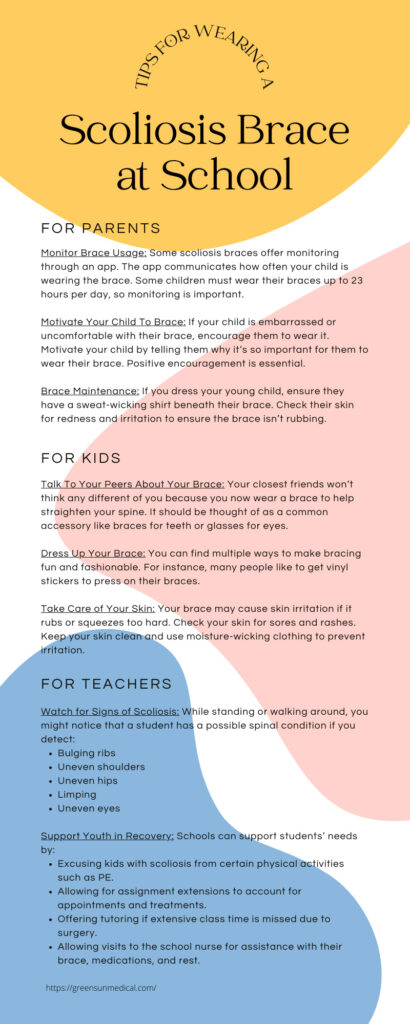About seven million people in the United States have scoliosis, making it a very common condition, though the cause is unknown in most cases. Many people who have scoliosis develop the condition during childhood. Treatments for scoliosis vary and can include physical therapy and surgery, but one of the most popular is bracing. Kids who wear a brace to treat scoliosis sometimes face social and emotional challenges because of stigmas. This experience can compound in new environments, like when school starts back up. Here are some tips for wearing a scoliosis brace at school and making the transition easier.
For Parents
Each parent reacts differently to finding out their child needs to wear a brace for scoliosis. Both the cost for this treatment and the news that your child’s condition has developed to a stage where bracing is required can lead to uncomfortable feelings. The most important thing you can do to ensure treatment is effective is support and encourage your child to wear the brace. While using and caring for the brace seems like mainly your child’s responsibility, there are a few things you can do to help.
Monitor Brace Usage
Some children want to wear their brace and won’t hesitate to put it on daily. You may not even notice they have it on if they enjoy finding ways to make it blend into their clothing. Rather than constantly asking if they are wearing the brace, you may be able to monitor their usage more precisely. Some scoliosis braces offer monitoring through an app. The app communicates how often your child is wearing the brace. Some children must wear their braces up to 23 hours per day, so monitoring is important.
Motivate Your Child To Wear Their Brace
If your child is embarrassed or uncomfortable with their brace, encourage them to wear it. Motivate your child by telling them why it’s so important for them to wear their brace. Positive encouragement is essential. Try not to give them negative scenarios to think about so they are scared into wearing their brace. The goal should be for them to feel happy and empowered in their brace. Don’t let treatment for their condition become a traumatic experience. With the right guidance, you can show your child that bracing doesn’t make them different from any other child being treated to correct a medical condition (i.e. braces for crooked teeth or wearing a cast for a broken bone).
Brace Maintenance
To keep bracing enjoyable and to make sure your child continues to use it, you should help with care and maintenance. If you dress your young child, ensure they have a sweat-wicking shirt beneath their brace. Check their skin for redness and irritation to ensure the brace isn’t rubbing. If sores or a rash appear, reach out to your child’s doctor.
For Kids
Diagnosis with scoliosis may be harder for a child than their parent. Depending on the age of the patient and the progression of the condition, bracing may be the best option to prevent surgery. Any patient’s likelihood for success is based on how committed they are to treatment. Most people with scoliosis receive the diagnosis at a young age. Getting through school is easier when you have the right coping mechanisms.
Talk To Your Peers About Your Brace
It may not seem natural at first, but communicating about your condition may make it easier in the long run. For instance, if you’re nervous that your friends will find out about your brace, you can face that fear head-on by simply telling them. Your closest friends won’t think any different of you because you now wear a brace to help straighten your spine. It should be thought of as a common accessory like braces for teeth or glasses for eyes. A scoliosis brace is a temporary support, and it doesn’t change who you are.
Dress Up Your Brace
You can find multiple ways to make bracing fun and fashionable. For instance, many people like to get vinyl stickers to press on their braces. Let each of your friends design one, so they each have a special place on your cool brace. Furthermore, there are many types of clothing that can be worn over the brace to disguise it. Leggings easily stretch over odd angles, and loose shirts, hoodies, and flowy dresses can cover uneven edges.
Take Care of Your Skin
Your brace may cause skin irritation if it rubs or squeezes too hard. Check your skin for sores and rashes. Keep your skin clean and use moisture-wicking clothing to prevent irritation.
Seek Counseling
Bracing can take an emotional toll, especially when it comes to returning to school. Even if you decide to tell your closest friends, you may not trust the rest of the school to be as kind as they are. Teachers, coaches, and other staff may not understand your condition. If you become self-conscious and depressed about your condition and it starts impacting your willingness to use your brace, it might be time to talk to a counseling professional.
For Teachers
Watch for Signs of Scoliosis
As a teacher, you support children of all shapes, sizes, and backgrounds. You never know what kind of support kids are receiving at home. You can reach out to parents or counselors if you notice visual asymmetries that you believe might be serious. Not all schools check children for scoliosis, and some signs are more obvious than others. While standing or walking around, you might notice that a student has a possible spinal condition if you detect:
- Bulging ribs
- Uneven shoulders
- Uneven hips
- Limping
- Uneven eyes
Support Youth in Recovery
It’s not uncommon for schools to support children with scoliosis at any age. If your classroom includes a student with this condition, you can help them by encouraging them to participate in the same activities as everyone else. Bracing for scoliosis may make some children feel embarrassed or self-conscious due to their limitations. Schools can support students’ needs by:
- Excusing kids with scoliosis from certain physical activities such as PE;
- Allowing for assignment extensions to account for appointments and treatments;
- Offering tutoring if extensive class time is missed due to surgery; and
- Allowing visits to the school nurse for assistance with their brace, medications, and rest.
Children can’t take on scoliosis alone. Teachers, parents, and peers must come together to help kids in need get through each stage of development. The best tips for wearing a scoliosis brace at school are to communicate, be flexible, and seek counseling when necessary. Don’t pretend to have the answers if you don’t. Look to someone with more experience who might be able to offer guidance and support in the areas you need.


